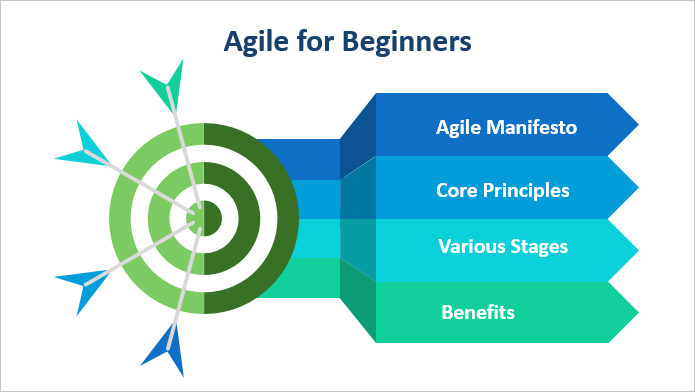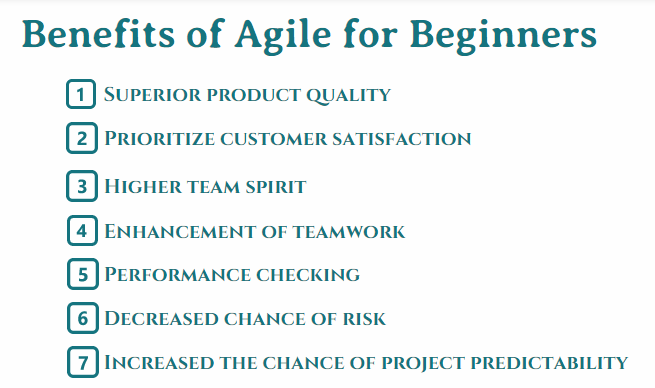
Overview of Agile for Beginners
Agile is an extensive and comprehensive term to expedite the process of software development more effectively and deliberate. Agile has gained extreme popularity during this decade due to its incremental and iterative approach to delivering high-quality software with salient features without crossing the past deadline and budget. In this topic, we are going to learn about Agile for Beginners.
On the other side, Dummies is a podium that transforms any non-comprehensive topic into simply understandable through various methods, including expert editorials, sharing experiences through amicable styles, and so on. Dummy supports a learner to enhance knowledge level in pursuit of professional development and personal advancement. Agile beginners provide a platform to realize. Agile project management approaches for continuous improvement, increasing the team’s input, and bringing the quality product.
Generally, all the Agile methods adhere to the guidance provided by the Agile manifesto and 12 core principles, which emphasize on people, communication, flexibility, and product.
Agile Manifesto
The manifesto for Agile software development, usually known as the Agile Manifesto, is a complete guideline and the expression of core values of project management.
“We are uncovering better ways of developing software by doing it and helping others do it. Through this work, we have come to value:”
- Individuals and interactions over processes and tools determine effective teamwork. Process and tools never create a product; only people can make it with the aid of tools and processes.
- Working software over comprehensive documentation emphasizes the use of documentation process only for software development. Unlike the Waterfall model, a detailed and comprehensive documentation process will be valueless if it doesn’t meet customer requirements.
- Customer collaboration over contract negotiation means customer association throughout the software development process which adds value over mere paperwork.
- Responding to a change over following a plan gives emphasis on flexibility. The agile methodology encourages flexibility approach to adopt any new change aligning with previous planning.
12 Core Principles of Agile for Beginners
The Agile manifesto follows 12 core principles of project development. These principles are the guiding perception of project development which helps the project team to be agile in the work and thinking pattern of the project.
- The ultimate priority is to earn customer satisfaction by delivering a quality product at the right time.
- Changing, if required, is always acceptable in the Agile process because it gives benefits to customers.
- Being capable of delivering working software within a short time span, from a couple of weeks to a couple of months.
- As a team, the developers and business people must work together during the project.
- Create an environment that individuals get motivated. That is why the individuals must get responsibility, support, and trust for the completion of the assigned task.
- Effective communication is another important part of project development. Face-to-face conversation within the development team is the most efficient and effective way of conveying information,
- Working software is the key portion of progress.
- Agile processes ensure constant development, and so the developers, sponsors, users must maintain a pace.
- Continuous attention towards technical upgradation and good design increases agility.
- Simplicity is another keyword in the Agile process.
- Requirements, the best architecture, and design appear from the best organized team.
- On a regular basis, the team must check their actual performance level and reflect on those areas that need to be developed to become more effective.
Various stages of Agile Process
The agile project development process has seven crucial stages for developing products.
- The project planning is the initial stage that defines the project vision, product roadmap and estimation of time required to produce the product.
- Planning to release the next set of product features and fixing a date for launching a product is the part of the Agile process for which the team has to work.
- Sprint, sometimes known as iteration, exists between one to four weeks. During the sprint, the team members plan for future work on the basis of past performance. Therefore, the time span of the sprint should limit within four weeks throughout the project.
- Sprint planning is the beginning of a sprint where the team members commit to a sprint goal and also identify the requirement that supports the goal. It also assigns the task to individuals.
- The daily scrum is a 15-minute coordination and synchronization meeting where team members describe their previous day’s work and today’s target of work. Here they also discuss the roadblocks facing in the project.
- The sprint review is organized at the end of a sprint where the team members exhibit the product functionality to the stakeholder, and the product owner collects the feedback to keep the record for the product backlog.
- In the sprint retrospective, the scrum team members discuss the adaptation of any new changes and implementation at the next sprint.
Benefits of Agile for Beginners
Agile beginners explore the platform to obtain proper knowledge about the Agile approach, which provides numerous benefits to organizations, project teams and products. The crucial benefits are as follows –
1) Superior product quality: Agile approaches ensure to produce extremely good quality products as possible so that
- Taking proactive action to improve product problems.
- Implementation of technological advancement.
- Addition of daily testing and continuous integration in the development process.
- Application of technical advancement tools.
2) Prioritize customer satisfaction: In the Agile process, the customers are satisfied by
- Keeping updated about the product throughout the project.
- Keeping the product backlog updated.
- Compelled to give information about working to customers in every sprint review.
- Involving a product owner who must have knowledge about product requirements and customer needs.
3) Higher team spirit: In the Agile process, every team member gets encouragement to be creative and innovative. In addition, working cross-functionality gives the opportunity to learn a new skill.
4) Enhancement of teamwork: In daily scrum meetings and sprint reviews, the developer’s team, product owner and scrum masterwork together, which enhances coordination and collaboration among them.
5) Performance checking: In the Agile process, every people who involve with the project gets the opportunity to check their current performance level. Daily scrum meetings, sprint review, visibility chart helps to measure the concrete view of progress.
6) Decreased chance of risk: Agile process eliminates the chance of risk factors of project failure.
7) Increased the chance of project predictability: Agile project management approach includes several practices, artifacts, and tools to improve the chance of project predictability.
Recommended Articles
This is a guide to Agile for Beginners. Here we also discuss the Core Principles, Various Stages, and Benefits of Agile for Beginners. You may also have a look at the following articles to learn more-


